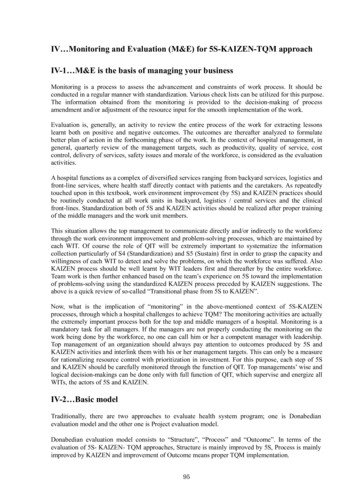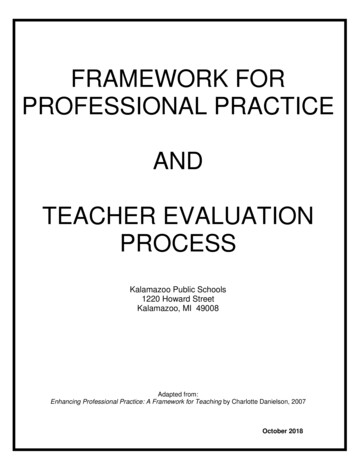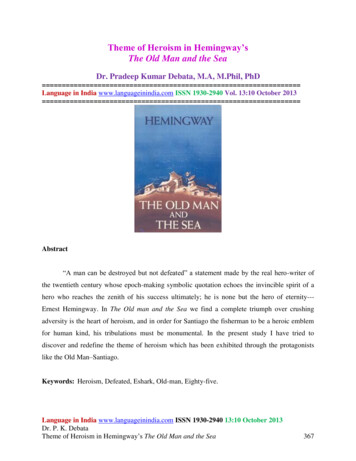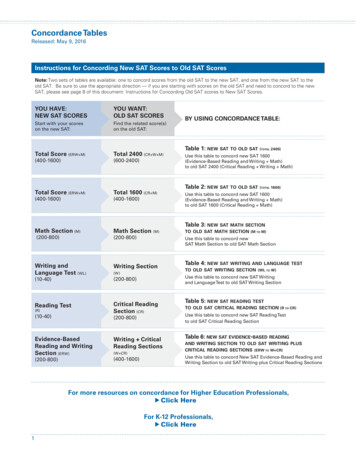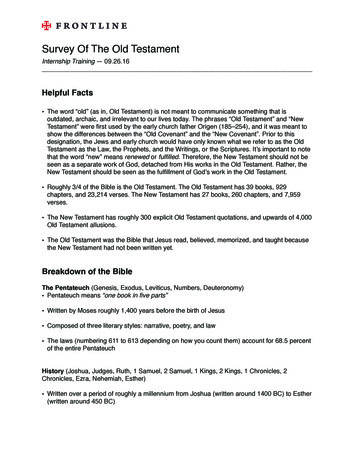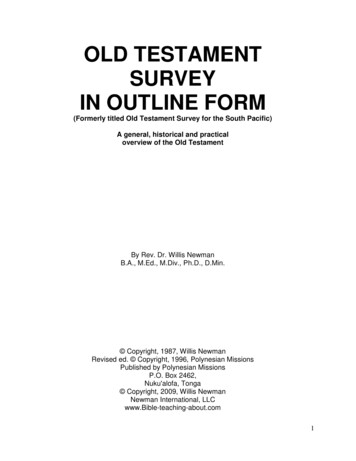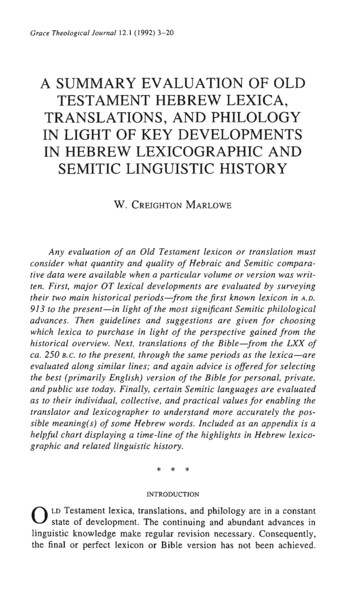
Transcription
Grace Theological Journal 12.1 (1992) 3-20A SUMMARY EVALUATION OF OLDTESTAMENT HEBREW LEXICA,TRANSLATIONS, AND PHILOLOGYIN LIGHT OF KEY DEVELOPMENTSIN HEBREW LEXICOGRAPHIC ANDSEMITIC LINGUISTIC HISTORYW.CREIGHTON MARLOWEAny evaluation of an Old Testament lexicon or translation mustconsider what quantity and quality of Hebraic and Semitic comparative data were available when a particular volume or version was written. First, major aT lexical developments are evaluated by surveyingtheir two main historical periods-from the first known lexicon in A.D.913 to the present-in light of the most significant Semitic philologicaladvances. Then guidelines and suggestions are given for choosingwhich lexica to purchase in light of the perspective gained from thehistorical overview. Next, translations of the Bible-from the LXX ofca. 250 B.C. to the present, through the same periods as the lexica-areevaluated along similar lines; and again advice is offered for selectingthe best (primarily English) version of the Bible for personal, private,and public use today. Finally, certain Semitic languages are evaluatedas to their individual, collective, and practical values for enabling thetranslator and lexicographer to understand more accurately the possible meaning( s) of some Hebrew words. Included as an appendix is ahelpful chart displaying a time-line of the highlights in Hebrew lexicographic and related linguistic history.* * *INTRODUCTIONOTestament lexica, translations, and philology are in a constantstate of development. The continuing and abundant advances inlinguistic knowledge make regular revision necessary. Consequently,the final or perfect lexicon or Bible version has not been achieved.LD
4GRACE THEOLOGICAL JOURNALMany agree that the recent discovery and decipherment of a lost Semitic language at Ebla will not be the last such revelation coming fromthe science of archaeology. Any evaluation of an Old Testament lexicon or translation must consider what quantity and quality of Hebraicand Semitic comparative data were available when they were written.The value of a Semitic language for Hebrew philology is judged inlight of its extent of textual information and the nature of its relationship to Hebrew.THE LEXICA EVALUATEDThis evaluation, like those following, will be a general, summaryappraisal of the subject-lexica in this case-by periods. Each lexiconwill not be examined in depth; but the nature of the philological context-affecting the potential of each to describe accurately the usage ofthe entire Biblical Hebrew vocabulary-will be reviewed.During the Formative Period (A.D. 913-1810)Hebrew lexica written during this era greatly differed as to howwell the Hebrew language was understood when each was composed.Lexicographers such as Saadiah, Ben Abraham, and Saruq workedprior to the establishment of the rule of triradical roots during the lasthalf of the tenth century. Arabic was the major comparative source forsolving lexical problems throughout the period. Akkadian and Ugariticwere totally unknown. The creation of Hebrew linguistics and philology took place in the eleventh and first half of the twelfth centuries.Yet monoliteral roots were still recognized when Ibn Janach's dictionary appeared in the 1040s. Not until ca. 1437-45 did the first Hebrewconcordance come on the scene. Christian lexicographers (1506-) suchas Reuchlin, Pagninus, Buxtorf, and Simonis depended on Jewish tradition almost exclusively. For the most part, however, Jewish lexicographic scholarship ceased from ca. 1500-1700. Christian dictionarieswere heir to few advances during these years. Lexica produced before1753 were prior to Robert Lowth's revelation of the true nature (parallelism) of Hebrew poetry. Lexica of the formative period of Hebrewlexicography, in general, clearly were very inadequate by today'sstandards; but the major works apparently were thorough and quiteextensive. The lexicographers were highly skilled linguists for theirday and very competent at handling difficult forms in light of their contexts. Present students of the Hebrew Bible can profit from these lexicaby observing the often insightful interpretations of medieval philologists working without the elaborate tools and Semitic data availabletoday.
A SUMMARY EVALUATION5During the Scientific Period (A.D. 1810-)Hebrew lexica of the scientific period of Hebrew lexicographywere developed during two distinct sub-periods: (1) the classical yearsdominated by the lexicographic innovations and insights of WilhelmGesenius; and (2) the modern years characterized by an unparalleledrecovery and development of Semitic linguistic aids, which includedthe discovery and decipherment of Akkadian, Ugaritic, and Eblaite.During the classical years (1810-71)Hebrew lexica compiled during these years were all influencedas all subsequent lexica-by the scientific method that Geseniusbrought to lexicography. Most of the dictionaries were either revisionsor translations of Gesenius' works. Akkadian was discovered and deciphered during the last half of this period; but no lexicon incorporatedits data until 1871, which marked the beginning of a new stage inHebrew lexicography. Thus Arabic, at times abused, was still themajor comparative source for solving lexical difficulties. Those whotranslated Gesenius, like Samuel P. Tregelles, gave few thoughts oftheir own and, overall, tried to represent only Gesenius' lexicography.Also following Gesenius, these lexica sought to place every Old Testament Hebrew word under a basic root, whether verified or theoretical.For some lexically difficult words, unfortunate comparisons to IndoEuropean languages were made in order to postulate a definition. Outside of the initial advances Gesenius brought to the science of lexicography and the use of comparative information, few advances occurredin Semitic linguistics. Moabite was discovered in 1868. The value ofthese lexica following Gesenius have been indebted to his pioneeringefforts and now classical approach, which have made his lexica standard works. Although the lexica of the classical years are now outdated, they offer the results of Gesenius' genius for consideration,especially for some lexical problems in the Old Testament.During the modern years (1871-)The modern years of Hebrew lexicography were marked by themost rapid developments in Semitic philology. Many advances wereintroduced into the lexica, as a result, which were never before possible. Since 1871 Akkadian and Ugaritic linguistic information hasbecome available; the former was discovered earlier but utilized sincethe date given, while the latter was discovered in 1928-30 but not usedin a lexicon until 1953. Other linguistic developments since the lastthird of the nineteenth century were the plethora of related Semitic literary finds and the recovery of the language and literature of ancient
6GRACE THEOLOGICAL JOURNALEbla. All of this has allowed lexicographers to identify homonymswhich lexicographers without this information were unable to recognize or substantiate. One of Gesenius' major weaknesses was his failure to list many homonyms as separate entries because he equatedthem with the same basic root. 1 The establishment of proper andunforced homonymic roots is a challenge which had a far less chanceof success before the comparatiYe data from Semitic philology-sincethe beginning of the twentieth century-were available. In this lightand for the American scholar, the lexica by Brown, Driver, and Briggs;Kohler and Baumgartner; and Holladay2 should all be consulted at thevery least when a lexical question arises. These, naturally, differ in thequantity and quality of their information.Choosing a LexiconA question frequently asked by seminary students is: "Which lexicon is the one to purchase?" This immediately demonstrates theirgreat misunderstanding of the lexica they use and the history of lexicographic development. Moises Silva wrote:Lexicology takes priority in the exegetical process. We may pursue theanalogy and suggest that, although not every exegete need become a professional textual critic, every exegete must have sufficient involvement inthat work to evaluate and assimilate the results of the "experts." Similarly, all biblical interpreters need exposure to and experience in lexicographic method if they would use the linguistic data in a responsible way.In a survey of biblical scholars and students conducted in the late1960s, some respondents commented on the need for "a better understanding of the nature, use, and limitations of a lexicon" on the part ofdictionary users.58 The point . is still valid today. This requisite understanding, however, can only be developed on the basis of a solid grasp ofthe theoretical foundations of lexicology.3IE. F. Miller, The Influence of Gesenius on Hebrew Lexicography (New York: Columbia University Press, 1927; reprinted, New York: AMS, 1966) 49-50.2See F. Brown, S. R. Driver, and C. A. Briggs, eds., A Hebrew and English Lexiconof the Old Testament (Oxford: Clarendon, 1907); L. H. Kohler and W. Baumgartner, eds.,Lexicon in Veteris Testamenti Libros (2d ed.; Leiden: E. J. Brill, 1958); L. H. Kohleret aI., Hebraischen und aramaischen Lexikon zum Alten Testament (3d ed.; 2 vols.; Leiden: E. J. Brill, 1967-); and W. L. Holladay, ed., A Concise Hebrew and Aramaic Lexicon of the Old Testament (Leiden: E. J. Brill, 1971; reprinted, Grand Rapids: William B.Eerdmans, n.d.).3M. Silva, Biblical Words & Their Meaning: An Introduction to Lexical Semantics(Grand Rapids: Zondervan, 1983) 31-32, citing J. E. Gates, An Analysis of the Lexicographic Resources Used by American Biblical Scholars Today (Missoula, Montana:SBLDS, 1972) 134.
A SUMMARY EVALUATION7The serious exegete of the Old Testament cannot rely on just onelexicon. A number of them have varying degrees of value for the student of Hebrew today. The most valuable are those which have beencompiled within the context of modern Semitic philology; that is, theones which were able to utilize Akkadian or, better yet, Akkadian andUgaritic when the study of these languages reached a state of maturity.Because of its early date, the lexicon by Brown, Driver, and Briggs issometimes inaccurate in its use of Akkadian. 4 Even at the present datethe Chicago Assyrian Dictionary5 (hereafter CAD) remains incomplete. Still, Brown-Driver-Briggs (or BDB by its popular acronym)preserves an updated version of Gesenius' lexicography. Kohler andBaumgartner's first lexicon, along with its supplement volume, offersthe lexical description of Hebrew vocabulary that is heir to the fiftyyears of Semitic linguistic advances following BDB. Yet it cannot befollowed blindly or uncritically in every application of Akkadian orU garitic. 6 Much has been learned in the quarter-century since theywere published. The recently completed Hebrew portion (four vols.) ofa new German Hebrew-Aramaic lexicon (edited initially by KohlerBaumgartner and continued by Kutscher-Hartmann, et al.; see n. 2,p. 6) promises to be the most philologically complete and correct lexicon to date; but the rapid rate at which such data are presently beingmade available will eventually make any current lexicon somewhatoutdated. This is especially true of the earlier volumes because of thelarge number of years involved in writing a Hebrew lexicon. The first4This is not to indicate they erroneously used the information but that the data athand was sometimes faulty by today's standards; that is, some of the Akkadian lexicaldata they consulted is now outdated. An example is the suggestion of l,lllu as a cognate(s.v.l,lfil) to support the meaning "dance," to which CAD gives no related definition.5I. J. Gelt et aI., eds., The Assyrian Dictionary of the Oriental Institute of the University of Chicago (Chicago: Oriental Institute, 1956-).6L. Kohler, Lexicon in Veteris Testamenti Libros s.v. "zrb"; CAD s.v. " arapu";Holladay, A Concise Hebrew and Aramaic Lexicon s.v. "zrb"; and L. Kohler et aI., Hebraisches und aramaisches Lexikon s.v. "zrb." Even though this lexicon was publishedfifty years later than BDB, it is now over twenty years since its first edition; so its weaknesses must be seen in the same light as that of BDB. An example is its explanation ofzrb, a hapax in Job 6:17, as meaning "to press" in light of the Akkadian cognate zurubu.More recently, however, the CAD has established the proper cognate as arapu, "toburn" (1961); and a decade later, Holladay's concise abridgement of the lexica based onthe editorship of Kohler and Baumgartner gave the meaning "dry up." However, thethird edition of the Kohler-Baumgartner lexicon (later edited by E. Y. Kutscher andB. Hartmann et aI.) arrived at the translation "scorch, burn" based on the Hebrew cognate rb. Unlike the second edition, the Syriac and Akkadian zrb "to press" was questioned but shown to be a solution offered by some. Most modern English versions-theNEB a notable exception-have adopted an idea related to "a time of heat or burning";cf. NIV, RSV, NASB, JB.
8GRACE THEOLOGICAL JOURNALtwo volumes of this latest Old Testament lexicon begun by Kohler andBaumgartner appeared in print during a nineteen-year period (196786); while volumes three and four were published, respectively, in1983 and 1990. William Holladay's abridged Hebrew lexicon (published in 1971) was able to make use of manuscript material for thisthird edition of Kohler-Baumgartner through the letter samek; but sucha concise work in English cannot substitute fully for the parent German production. Where Holladay could not rely on published orunpublished portions of that lexical project (letters cayin through taw),the same advantages obviously were not inherited and thus not incorporated. A comprehensive, up-to-date Hebrew lexicon in English isstill lacking among the existing and fully-published Old TestamentHebrew lexica. The student must ask: "What lexica should be owned?"No one lexicon is sufficient, or probably ever can be, for Hebrew exegesis. The careful student must, and the wise student will, consult avariety of the most complete and current lexica available. 7 Presently,the American student or scholar should at least consult the lexica byGesenius-Tregelles; Brown, Driver, and Briggs; Holladay; and KohlerBaumgartner.7See J. Barr, "Hebrew Lexicography," and P. Fronzaroli, "Problems of a SemiticEtymological Dictionary" in Studies on Semitic Lexicography (Florence: Instituto diLinguistica e di Lingue Orientali, 1973) 1-24, 103-26, for a detailed examination andexamples of the potential and problems of the latest lexica.Also the reader should be made aware of other lexica in production, especially onein English which will replace BDB and has reported good progress since work began inSeptember 1988. This lexicon, The Dictionary of Classical Hebrew, unlike previousworks and as its name implies, will seek to incorporate all the biblical and extra-biblicalremains of the Classical Hebrew language. The director and chief editor of the project isProfessor David J. A. Clines, University of Sheffield, with co-editors J. W. Rogerson andP. R. Davies. Also unlike BDB and other older lexica, the words will appear in alphabetical order. A special feature is the inclusion of syntagmatic information. The project isbeing carried out under the auspices of the Society for Old Testament Studies.Fascicules and the first volume of the third edition of Kohler-Baumgartner appearedin 1967. The lengthy production schedule created a further delay in that it became necessary to complete the project under the new general editorship of E. Y. Kutscher andB. Hartmann.Other lexica underway include, most importantly, another remake (the eighteenthedition) of Gesenius' Handworterbuch, of which the first volume, prepared by R. Meyerand H. Donner, has appeared. Two features will make this a very valuable addition to thefield of Hebrew lexicography and set it apart from the other German and especially theEnglish lexica discussed above. Even more than the aforementioned German work and incontradistinction to the "new BDB," in true Gesenius style this dictionary will containan abundance of references to cognate Semitic languages and to scholarly word studiesin bibliographic entries. Like the other German but unlike the latest and novel Englishapproach, it remains strictly a dictionary of the remains of Classical Hebrew in the OldTestament; however, its treatment of the Ben Sira and Qumran materials is more extensive than that in any previously published Hebrew lexica. See D. J. A. Clines, editor, and
A SUMMARY EVALUATION9THE TRANS LA TIONS EVALUATEDAs with the lexica the value of any translation of the Hebrew OldTestament is partly determined by the quality of the linguistic toolsin this case mainly the lexica themselves-used by the translators.Since accurate translation is dependent on sound exegesis, which inturn is dependent on the best lexica, what was generally noted aboutthe linguistic and lexicographic climate of the periods of Hebrew lexicography applies to the potential of any versions produced within thesame periods. The following will focus on a few representative OTtranslations of each period and suggest why extreme views regardingthe priority of anyone translation be abandoned.During the Preparatory Period (before A.D. 913)No known Hebrew lexicon was created during this era. Threemajor translation projects of the Hebrew Scriptures were: (l) the Greekversion of ca. 250 B.C. (the LXX, or Septuagint); (2) the Syriac versionof possibly A.D. 40-70 (the Peshitta); and (3) the Latin version ofA.D. 390-405 (the Vulgate). Each of these clearly was written beforeany science of Hebrew linguistics or philology in the modern sensedeveloped. On the other hand, they were composed at a time whichpossibly preserved lexical knowledge of Hebrew that was lost to latergenerations. The exact nature and value of these versions is a subjectthat is highly complex and technical and has been extensively debated.The concern here is merely to point out the apparent Semitic linguisticcontext in which their translators worked. In this case little is knownspecifically, but all these translations show that often the translatorswere not willing or able to render adequately the Hebrew text beforethem. 8 Yet these versions remain very valuable for exegesis becausethey sometimes preserve a reading preferable to that in the Masoretictext or proposed by a lexicon. As the examples that are charted at theend of the next major evaluative section (p. 14) would show in someinstances when investigated as regards their translation history, sometimes an ancient version contains the rendering not followed by subsequent versions and lexicographers but recovered and substantiated bydata from modern Semitic philology.J. W. Rogerson and P. R. Davies, co-editors, "The Dictionary of Classical Hebrew:Newsletter 1" (University of Sheffield, July 1988) 1-2, and Clines, "Newsletter 2" (December 1988) 1-2, for the basis of much of and further elaboration on the informationcontained in this endnote.8See E. Wtirthwein, The Text of the Old Testament (Grand Rapids: William B.Eerdmans, 1979) 47-83; and S. P. Brock, "The Phenomenon of Biblical Translation inAntiquity" in Studies in the Septuagint (New York: KTAV, 1974) 541-71.
10GRACE THEOLOGICAL JOURNALThe Syriac Bible, or Peshitta, requires special consideration atthis point in regard to a modern theory about its value. George M.Lamsa sought to popularize the view that the Syriac Bible representsthe original language and idioms of biblical revelation, rather thanHebrew and Greek. In 1957 his English translation of the Peshitta9 waspublished. His claim was that Aramaic was the more natural languageof discourse for the biblical writers. However, the Aramaic they spokewas western Aramaic, whereas Syriac is eastern Aramaic. Syriac is notthe Aramaic of the Old Testament. Besides, evidence of written or oralAramaic originals of the Hebrew Bible is speculative. As indicatedabove, the Syriac Bible sometimes might contain the more originalreading; but Lamsa has sought not to revise but to replace the Hebrewtext with a much later Syriac text. Unless his presupposition isaccepted, his novel renderings usually are unnecessary because theHebrew is clear and contextually valid. He is often helpful with hapaxlegomena and other difficult words. As an example of the former, thePeshitta has "venom" where the Hebrew has "wine" in Deut 32:33; butthe context favors the Hebrew meaning.During the Formative Period (A.D. 913-1810)During this initial stage of lexicographic growth, important translations appeared such as: (1) the Arabic version of ca. A.D. 1000; (2)the German version by Luther in ca. 1532; and (3) the Authorized, orKing James, English Version of 1611. The theoretical common Semiticvocabulary stock available to the translators of the LXX, if it existedthen, was a long-lost resource by the time of the Christian era. Christian Hebraists of the Middle Ages were dependent on Jewish tradition;and Arabic dominated comparative linguistics. Knowledge of theHebrew language had waned among Christian scholars because of disinterest until the sixteenth century, when Jewish Hebraic studiesdeclined.Before 1500 the understanding of Hebrew was incomplete and attimes incorrect on basic matters; but from 1500-1810-with the lossof Jewish scholarship leading the way-few advances were made. Thisstate of Hebraic knowledge was reflected by the lexica and translations. The Old Testament was not translated as often as the New, andsome translators were guided by literary as much as-possibly in afew cases more than-exegetical purposes. The versions of this periodare not valuable as witnesses to the original text; but they are helpfulin a supporting role, when a reading is suggested by stronger evidence.9See G. M. Lamsa, The Holy Bible: From Ancient Eastern Manuscripts (16th ed.;Philadelphia: A. J. Holman, 1957) v-viii.
A SUMMARY EVALUATION11The translators of this period were greatly influenced by and dependenton former translations, especially the LXX and Vulgate and especiallyfor rare and difficult Hebrew words. The Authorized Version is theoutstanding example.A number of comments are necessary concerning the AuthorizedVersion (A V hereafter) in particular because of its long history of popularity and in light of a current problem stemming from an untenableclaim about its value as a Bible version. Like all translators, the KingJames committee members were products of their lexicographic climate, which by today's standards and Semitic linguistic situation wasseverely limited. Many of the best English Hebraists of that day, however, were involved in the translation process. At the same time, theirpurpose should not be forgotten. In the" Address to the Reader" -leftout of most modern printings of the A V -the translators stated theirpurpose and policies. They let it be known that their purpose was not"to make a new translation but a traditional one,,,l0 that is, in the tradition of the Vulgate and previous English versions with which Europeans were familiar. So their purpose was more literary than linguistic.At the same time, their Semitic linguistic climate was limited, prescientific in the modern sense, and lacking the aids of modern philology. The reason the A V failed to put the great amount of OT poetryin poetic stanzas was that it was made more than a century beforeLowth revealed the nature of Hebrew poetry. The translators may havesensed a little about the feature of parallelism in Hebrew, but theirwork shows it was not fully appreciated until after Lowth. As demonstrated by the chart on p. 18, the King James translators could not adequately deal with many hapax legomena because they lacked theadvances in Semitic philology available now. Because such discoveries have been so late, the numerous lexical changes needed in the OTwere much less noticeable. Thus new translations were rarely calledfor, and the AV remained popular for over three hundred years.A current problem is that the A V has remained popular and is themost popular English version today because of its beauty and traditionin spite of its lack of accuracy and clarity. The same twentieth-centuryperson who would never read a seventeenth-century book wants aseventeenth-century version of the Bible. Coupled with this is the current claim by many-of whom some have scholarly credentials-thatthe King James Version is the perfect written Word of God in English.for all time. This has come in the period of Hebrew lexicography whenthe need for new translations and their constant revision is undeniable inlight of the evidence from linguistic and philological study related to thebiblical languages. No argument is being made against those who wishION.Frye, The Great Code (San Diego: Harcourt, Brace, Jovanovich, 1982) xiii.
12GRACE THEOLOGICAL JOURNALto follow the Textus Receptus, 11 but those who so choose must seek thebest translation of that New Testament and the Masoretic text. In 1611the A V was it, but not now.During the Scientific Period (A.D. 1810-)The rest of this discussion of translations will focus on EnglishVersions. As indicated, no great need was felt for new Bible translations until the modern years of Hebrew lexicography (1871-). Numerous English versions have appeared during the twentieth century; andas many philological advances have progressively occurred, so havethe translations progressively improved as to the accuracy of solvinglexical problems in the Old Testament. The more recent versions standout in this area; but such changes have been incorporated very slowlyand conservatively.Choosing a TranslationThe use of data from Semitic philology affects the accuracy featureof good translation; however, the best translation- must have beauty andclarity as well. Thus one should use a translation that has taken intoaccount the most recent linguistic findings-not necessarily the mostrecent proposals, uncritically-and is readable, yet written in the beststyle its language offers for the age in which the translation is done. Thereader is most interested in what the Bible says so he can interpret whatit means; consequently, the lexical aspect is primary to the value of atranslation. The best translations, however, are not those which have beenIlNeither does the author accept the Textus Receptus as the most authentic representation of the original Greek New Testament text, but the issue concerns the choosingof the best English translation no matter which tradition of textual transmission is followed. Siding with the TR does not necessitate staying with the A V/KJV as the finalword in translating the TR. Also this debate has no bearing on the OT text, where theMasoretic text is accepted by most translators as the primary textual witness to the original Hebrew Scriptures. Witnesses to other textual traditions (the Septuagint, SamaritanPentateuch, and the Qumran documents-which latter recension reflects the two othersnamed and the MT) are consulted for variant readings by all who employ the science oftextual criticism; but those who believe the AV possesses a special sacred quality as anEnglish version look to no other OT text than the MT as being fundamentally the "TR"of the Hebrew Bible. Thus they must deal with the same basic issue in relation to the OTas noted above with the NT, but without clouding the discussion by accusing their opponents of using the wrong Hebrew or OT text. Those who postulate the primacy of the AVof 1611 based on a preference for the TR must still explain the supposed supreme accuracy of that translation for the OT in light of an abundantly increasing accurate knowledge of Hebrew grammar and lexicography since that time, coming from the manycomparatively recent developments and advances in Semitic linguistics and comparativeand cognate studies.
A SUMMARY EVALUATION13influenced the most by Semitic comparative linguistics but those whichhave accepted the most certain results of the lexical light from cognatestudies. An example of the former is The Anchor Bible commentary andtranslation, which frequently treats the Old Testament as more of aUgaritic than a Hebrew document. An example of the latter is the NIV.A translation should never be chosen on the basis of traditionalone. Accuracy is the foremost but not the only guide. The Biblereader finds differences in translations because of differences in perspective and knowledge when each was written. For example, the AVhas "spider" in Prov 30:28 where the NIV has "lizard." Both may be,and one has to be, incorrect. Of the two, the A V was written longbefore the meaning of the Hebrew behind these renderings wasanswered by available evidence from linguistic discoveries.As for the clarity of translations, the A V is full of words from theseventeenth century like "cockatrice" in Isa 59:5 ("vipers" in the NIV)and "reins" in Ps 139:13 (literally, "kidneys"; "inmost being" in theNIV), which almost no one who speaks modern English understands.The question "Which translation is best?" has the same problem as thesimilar query with the lexica. No serious Bible student can limit himself to just one translation for study. No perfect translation exists; theyall have a number of strengths and weaknesses. The A V excels in thebeauty of classical English prose; and even extreme renderings-thosethat abuse, refuse, or are unable to use data from Semitic philologyneed to be consulted at times. In light of the criteria established above,the most important English Old Testament versions are the JerusalemBible, New English Bible, New American Bible, and the New International Version. Those which should be regularly consulted for studyare, at least, the ones just mentioned plus the Septuagint, Vulgate, NewAmerican Standard Bible, Revised (or New Revised) Standard Version, The Anchor Bible Commentary, and the Berkeley Translation.The average English Bible r
the entire Biblical Hebrew vocabulary-will be reviewed. During the Formative Period (A.D. 913-1810) Hebrew lexica written during this era greatly differed as to how well the Hebrew language was un



